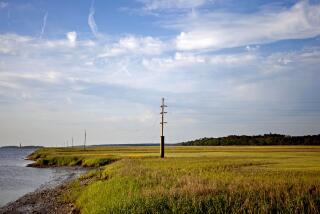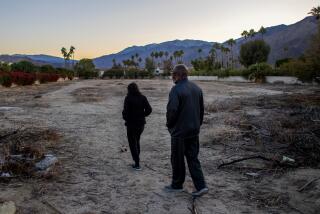Preservationists cherish beach’s black heritage
- Share via
AMERICAN BEACH, Fla. — When she was a young girl back in the mid-1950s, Marsha Dean Phelts rode to the beach each summer in the back of her daddy’s truck, loaded down with family, clothing and enough Nehi soda pop for a two-week stay.
“What I remember most was lots of sun and lots of sand,” recalled Phelts, 53, a Jacksonville librarian. “There was sand in the ham sandwiches and sand in the cake. But we didn’t mind. Because we were all together: Daddy, Mama, all the children, the cousins, my Sunday school classmates. There were tons of people, my people. And we were at our beach.”
Indeed, until the Civil Rights Act outlawed segregation in 1964, American Beach on Amelia Island was nearly the only stretch of seashore that blacks in this part of north Florida could enjoy. Founded in 1935 by insurance executive Abraham Lincoln Lewis, one of the nation’s first black millionaires, American Beach for 30 years thrived as a coastal community and vacation retreat for tens of thousands whose lives were delimited by the color of their skin.
The same legislation that did away with lawful discrimination signaled the community’s decline. Free to vacation elsewhere, regular visitors did. Clubs and motels closed, and some properties fell into disrepair.
Now the 30 families who live year-round in American Beach and are fighting to preserve its unique character face new threats. Sprawling developments catering to the wealthy are squeezing the 100-acre community from the north and south, while residents bicker over a zoning plan that would set limits on commercial development.
“This is a peaceful, quiet place, the only remaining African American coastal community in Florida,” said Annette M. Myers, president of the property owners’ association. “We all want to preserve the heritage and character. . . . And the best way to do that is for folks to invest in property here and then care for it.”
This barrier island north of Jacksonville, near Georgia, has a rich history. In the early 1800s, slave traders operated out of nearby Fernandina Beach. During the Civil War, the island was a staging area for the Union army. After the war, blacks homesteaded here, making a living by farming and fishing.
But it was the allure of the Atlantic Ocean, the sand dunes and the thick groves of live oaks and palms that led Lewis, a founder of the Afro-American Life Insurance Co., to establish a resort community for employees and their families. Soon Lewis began to sell $150 lots for vacation homes, and as the resort flourished during the 1940s and ‘50s, busloads of day-trippers were joined by celebrities: the writer Zora Neale Hurston, bandleader Cab Calloway, boxer Joe Louis and actor Ossie Davis.
In recent years, the historic tranquillity has been regularly shattered by throngs of young people from all over north Florida and even Georgia who gather to party in a beachfront parking lot.
Last summer, partyers were met on the one road into American Beach by Nassau County sheriff’s deputies with police dogs. While some residents objected to the tactics, Myers, Phelts and others applaud the restored serenity.
Officials of the neighboring resorts say they have no interest in swallowing up American Beach, which is divided into 50-by-100-foot lots controlled by about 230 owners. But the outside world threatens. Amelia Island Plantation, the 1,300-acre resort to the south, has built its maintenance sheds across the street from Phelts’ weekend home. On the other side of a narrow wooded buffer next to Myers’ historic coquina brick house is the Ritz-Carlton Hotel, where ocean-view rooms start at $239 a night.
Already named a stop on the Florida Black Heritage Trail, American Beach is a candidate for inclusion on the National Registry of Historic Places, Myers said. In the meantime, she is proposing--along with Nassau County Commissioner John Crawford--protective zoning.
“American Beach is a jewel worth polishing and saving,” said Crawford, who runs an insurance agency in Fernandina Beach. “There is a heritage there, a culture and a richness not found in other places.”
Phelts, who last year published a personal history called “An American Beach for African Americans,” admitted the difficulty of preserving the ambience of the place she knew as a child.
“I hope this is not all nostalgia,” Phelts said. “But there still is a contagious hospitality here. We don’t turn our heads when somebody passes by. In the tradition of Southerners, the hand goes up to say hello, and we even smile. We don’t want to see the end of that.”
Times researcher Anna M. Virtue contributed to this story.
More to Read
Sign up for The Wild
We’ll help you find the best places to hike, bike and run, as well as the perfect silent spots for meditation and yoga.
You may occasionally receive promotional content from the Los Angeles Times.






